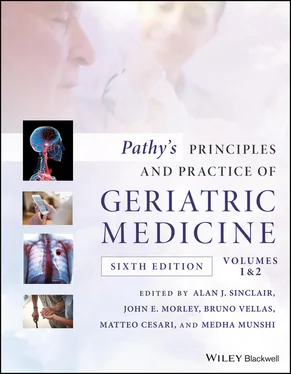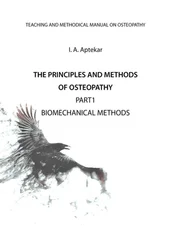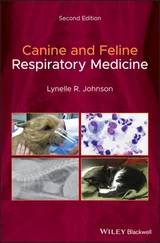Pathy's Principles and Practice of Geriatric Medicine
Здесь есть возможность читать онлайн «Pathy's Principles and Practice of Geriatric Medicine» — ознакомительный отрывок электронной книги совершенно бесплатно, а после прочтения отрывка купить полную версию. В некоторых случаях можно слушать аудио, скачать через торрент в формате fb2 и присутствует краткое содержание. Жанр: unrecognised, на английском языке. Описание произведения, (предисловие) а так же отзывы посетителей доступны на портале библиотеки ЛибКат.
- Название:Pathy's Principles and Practice of Geriatric Medicine
- Автор:
- Жанр:
- Год:неизвестен
- ISBN:нет данных
- Рейтинг книги:3 / 5. Голосов: 1
-
Избранное:Добавить в избранное
- Отзывы:
-
Ваша оценка:
- 60
- 1
- 2
- 3
- 4
- 5
Pathy's Principles and Practice of Geriatric Medicine: краткое содержание, описание и аннотация
Предлагаем к чтению аннотацию, описание, краткое содержание или предисловие (зависит от того, что написал сам автор книги «Pathy's Principles and Practice of Geriatric Medicine»). Если вы не нашли необходимую информацию о книге — напишите в комментариях, мы постараемся отыскать её.
Pathy’s Principles and Practice of Geriatric Medicine
Pathy's Principles and Practice of Geriatric Medicine — читать онлайн ознакомительный отрывок
Ниже представлен текст книги, разбитый по страницам. Система сохранения места последней прочитанной страницы, позволяет с удобством читать онлайн бесплатно книгу «Pathy's Principles and Practice of Geriatric Medicine», без необходимости каждый раз заново искать на чём Вы остановились. Поставьте закладку, и сможете в любой момент перейти на страницу, на которой закончили чтение.
Интервал:
Закладка:
Some patients may have persistent unexplained cytopenias with no or minimal dysplasia (non‐diagnostic for MSD), and this condition is called idiopathic cytopenia of undetermined significance (ICUS). In these conditions, regular monitoring is recommended at least every six months after the initial evaluation. 59
Table 26.5 International Prognosis Scoring System (IPSS) for MDS.
Source: Adapted from Greenberg et al. 6
| BM blasts (%) | Karyotype a | Cytopenias b | Score |
|---|---|---|---|
| <5 | Good | 0 or 1 | 0 |
| 5–10 | Intermediate | 2 or3 | 0.5 |
| Poor | 1.0 | ||
| 11–20 | 1.5 | ||
| 21–30 | 2.0 |
aKaryotype definitions: good, –Y, –5q, –20q, normal; poor, chromosome 7 abnormalities or complex karyotypes (three or more abnormalities); intermediate, all others.
bCytopenia definitions: haemoglobin, <10 g dl −1; absolute neutrophil count, <1800 μl −1; platelet count, <100,000 μl −1.
Prognosis
Several prognostic systems have been devised to better predict the outcome of individual patients. The IPSS 6has been in place since 1997. The prognostic score includes the percentage of blasts and number of cytopenias and cytogenetics 6( Tables 26.5and 26.6). Favourable cytogenetics includes the loss of the Y, 5q, or 20q chromosomes or the presence of a normal karyotype. Adverse cytogenetic changes were those with three or more cytogenetic abnormalities or any abnormalities involving chromosome 7. Number scores are attributed to each variable, thus dividing patients into four categories based on the sum of scores for each variable. The usefulness of the IPSS is limited by the fact that patients with secondary MDS were excluded from the analysis, and the information only pertains to patients at the time of diagnosis and cannot be used to estimate the real‐time risk for patients. Furthermore, it may underestimate the impact of cytogenetics.
Table 26.6 IPSS Survival for MDS and evolution to AML.
Source: Adapted from Greenberg et al. 6
| Risk category | Score | Median survival (years) in the absence of therapy | 25% AML progression (years) in the absence of therapy |
|---|---|---|---|
| Low | 0 | 5.7 | 9.4 |
| Intermediate‐1 | 0.5–1.0 | 3.5 | 3.3 |
| Intermediate‐2 | 1.5–2.0 | 1.1 | 1.1 |
| High | 2.5 | 0.4 | 0.2 |
The revised IPSS score (IPSS‐R) was published in 2012. 18This score includes a new cytogenetic risk classification that divides patients into five cytogenetic categories ( Table 26.7).
Table 26.7 Cytogenetic prognostic groups in the IPSS‐R.
Source: Adapted from Hong et al. 44
| Prognostic groups | Chromosomal categories | Median survival time (months) |
|---|---|---|
| Very good | del(11q), −Y | 60.8 |
| Good | Normal, del(5q), double aberrations including del(5q), del(12p), del(20q) | 48.5 |
| Intermediate | del(7q), +8, i(17q), +19, any other, independent clones | 25.0 |
| Poor | inv(3)/t(3q)/del(3q), −7, −7/7q, double aberrations including −7/7q−, complex karyotypes with 3 abnormalities | 15.0 |
| Very poor | Complex karyotypes with >3 abnormalities | 5.7 |
To overcome some of the limitations of the IPSS, which excludes patients with therapy‐related myelodysplastic syndrome, proliferative chronic myelomonocytic leukaemia, and those who have received prior therapy, a group at the University of Texas M.D. Anderson Cancer Center developed a new prognostic scoring system (MDACC) that included all of these patients. 61This model identified four prognostic groups based on a prognostic score that included age, performance status, platelet count, haemoglobin, white blood cell count, bone marrow blast percentage, complex karyotype, and chromosome 7 abnormality and prior transfusions.
In an attempt to incorporate dynamic variables such as transfusion burden, the WHO prognostic scoring system (WPSS), based on WHO 2008 categories, was developed. 62This model takes into account WHO subgroups, karyotype, and transfusion requirement to classify patients into five risk groups with variable median survivals (12–103 months) and probability of leukaemia conversion. The advantage of the WPSS is that it is a dynamic prognostic scoring system that can be used for patients at any time during the course of their disease.
A retrospective study by Fega et al. demonstrates that there are other significant predictors of survival in older adults. Low serum albumin, Charlson score, performance status, ability to take a long walk, and interference of physical symptoms in family life are significant predictors to consider. 63In the study, the multivariate model that best predicted mortality included low serum albumin, therapy‐related MDS, IPSS score, and ease taking a long walk.
Treatment
Management of MDS comprises supportive care and disease‐modifying agents. Supportive should be given to all patients, while high‐risk patients may be offered active treatments ranging from hypomethylating agents to intensive chemotherapy and haematopoietic stem cell transplantation. Recently, new agents have been proposed for treatments of low‐risk disease.
Treatment choice in older adults should not be based only on chronological age but should also take into consideration haematological variables (IPSS score, genetic risk) as well as variables derived from a CGA (comorbidity burden, self‐sufficiency, frailty status) and life expectancy. Patient preferences should always be taken into account.
Treatment of lower‐risk MDS
In lower‐risk MDS (PSS low/intermediate‐1, IPSS‐R very low, low, intermediate up to 3.5 points), goals of care are improvement of cytopenias, prevention of possible related complication (bleeding, infections), lowering the transfusion burden, and conservation of quality of life. In many older adults with mild and asymptomatic cytopenias, or in those with reduced life expectancy, watchful waiting is a reasonable option. An intensified surveillance program should be pursued for patients with higher‐risk genetic profile, especially those who are fit based on CGA and would be suitable for more intensive treatment strategies. During follow‐up, worsening of cytopenias and increasing number of blasts (either circulating or bone marrow) should prompt a re‐evaluation of the disease management plan.
Supportive measures for anaemia: erythroid‐stimulating agents
Anaemia may respond to the administration of erythroid‐stimulating agents (ESAs), 64‐66which is generally first‐line therapy for mild anaemia. Response to ESA therapy is influenced by the MDS prognostic category, level of baseline serum EPO, and degree of transfusion dependence. Prognostic models have been developed to predict the response to ESA. 67Lower levels of endogenous EPO, transfusion independence, and good‐risk MDS (based on IPSS classification) predict better response to ESA ( Table 26.8).
Erythroid‐stimulating agents (ESAs) are commonly used to treat MDS patients to reduce transfusion requirements. The use of ESAs in MDS is supported by the American Society of Hematology (ASH), the American Society of Clinical Oncology (ASCO), and the National Comprehensive Cancer Network (NCCN). 68,69
Two large phase 3 studies investigated the role of ESA in treating anaemia in MDS patients. 70,71Based on the results of these randomized controlled trials (RCTs), which showed a lower response rate for darbepoetin compared to epoetin‐alfa (14.7 versus 31.8%), EMA approved the use of the second one for this indication.
Читать дальшеИнтервал:
Закладка:
Похожие книги на «Pathy's Principles and Practice of Geriatric Medicine»
Представляем Вашему вниманию похожие книги на «Pathy's Principles and Practice of Geriatric Medicine» списком для выбора. Мы отобрали схожую по названию и смыслу литературу в надежде предоставить читателям больше вариантов отыскать новые, интересные, ещё непрочитанные произведения.
Обсуждение, отзывы о книге «Pathy's Principles and Practice of Geriatric Medicine» и просто собственные мнения читателей. Оставьте ваши комментарии, напишите, что Вы думаете о произведении, его смысле или главных героях. Укажите что конкретно понравилось, а что нет, и почему Вы так считаете.












